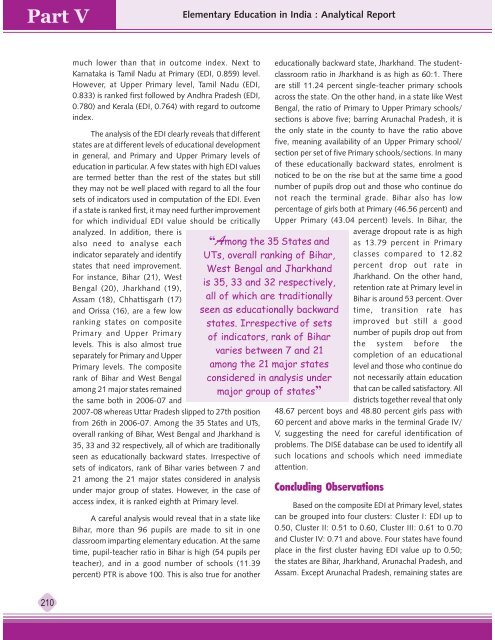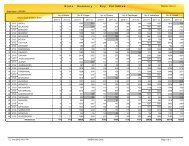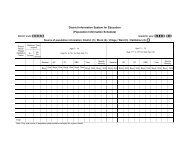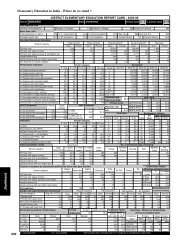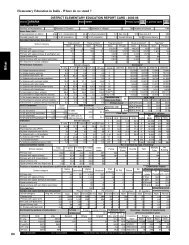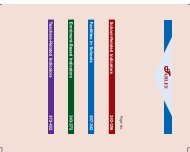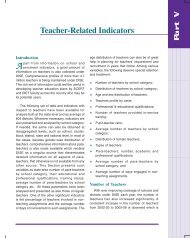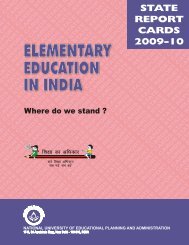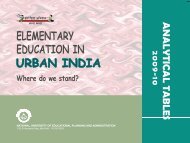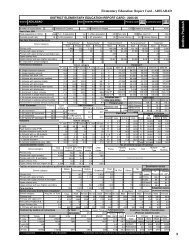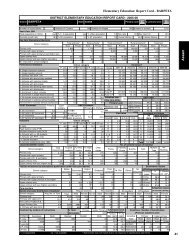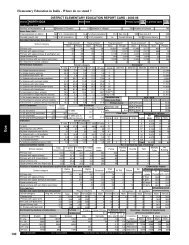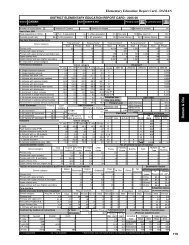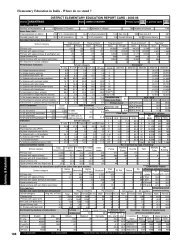Teacher Related Indicators & EDI - DISE
Teacher Related Indicators & EDI - DISE
Teacher Related Indicators & EDI - DISE
You also want an ePaper? Increase the reach of your titles
YUMPU automatically turns print PDFs into web optimized ePapers that Google loves.
Part V<br />
Elementary Education in India : Analytical Report<br />
much lower than that in outcome index. Next to<br />
Karnataka is Tamil Nadu at Primary (<strong>EDI</strong>, 0.859) level.<br />
However, at Upper Primary level, Tamil Nadu (<strong>EDI</strong>,<br />
0.833) is ranked first followed by Andhra Pradesh (<strong>EDI</strong>,<br />
0.780) and Kerala (<strong>EDI</strong>, 0.764) with regard to outcome<br />
index.<br />
The analysis of the <strong>EDI</strong> clearly reveals that different<br />
states are at different levels of educational development<br />
in general, and Primary and Upper Primary levels of<br />
education in particular. A few states with high <strong>EDI</strong> values<br />
are termed better than the rest of the states but still<br />
they may not be well placed with regard to all the four<br />
sets of indicators used in computation of the <strong>EDI</strong>. Even<br />
if a state is ranked first, it may need further improvement<br />
for which individual <strong>EDI</strong> value should be critically<br />
analyzed. In addition, there is<br />
also need to analyse each<br />
indicator separately and identify<br />
states that need improvement.<br />
For instance, Bihar (21), West<br />
Bengal (20), Jharkhand (19),<br />
Assam (18), Chhattisgarh (17)<br />
and Orissa (16), are a few low<br />
ranking states on composite<br />
Primary and Upper Primary<br />
levels. This is also almost true<br />
separately for Primary and Upper<br />
Primary levels. The composite<br />
rank of Bihar and West Bengal<br />
among 21 major states remained<br />
the same both in 2006-07 and<br />
2007-08 whereas Uttar Pradesh slipped to 27th position<br />
from 26th in 2006-07. Among the 35 States and UTs,<br />
overall ranking of Bihar, West Bengal and Jharkhand is<br />
35, 33 and 32 respectively, all of which are traditionally<br />
seen as educationally backward states. Irrespective of<br />
sets of indicators, rank of Bihar varies between 7 and<br />
21 among the 21 major states considered in analysis<br />
under major group of states. However, in the case of<br />
access index, it is ranked eighth at Primary level.<br />
A careful analysis would reveal that in a state like<br />
Bihar, more than 96 pupils are made to sit in one<br />
classroom imparting elementary education. At the same<br />
time, pupil-teacher ratio in Bihar is high (54 pupils per<br />
teacher), and in a good number of schools (11.39<br />
percent) PTR is above 100. This is also true for another<br />
“Among the 35 States and<br />
UTs, overall ranking of Bihar,<br />
West Bengal and Jharkhand<br />
is 35, 33 and 32 respectively,<br />
all of which are traditionally<br />
seen as educationally backward<br />
states. Irrespective of sets<br />
of indicators, rank of Bihar<br />
varies between 7 and 21<br />
among the 21 major states<br />
considered in analysis under<br />
major group of states”<br />
educationally backward state, Jharkhand. The studentclassroom<br />
ratio in Jharkhand is as high as 60:1. There<br />
are still 11.24 percent single-teacher primary schools<br />
across the state. On the other hand, in a state like West<br />
Bengal, the ratio of Primary to Upper Primary schools/<br />
sections is above five; barring Arunachal Pradesh, it is<br />
the only state in the county to have the ratio above<br />
five, meaning availability of an Upper Primary school/<br />
section per set of five Primary schools/sections. In many<br />
of these educationally backward states, enrolment is<br />
noticed to be on the rise but at the same time a good<br />
number of pupils drop out and those who continue do<br />
not reach the terminal grade. Bihar also has low<br />
percentage of girls both at Primary (46.56 percent) and<br />
Upper Primary (43.04 percent) levels. In Bihar, the<br />
average dropout rate is as high<br />
as 13.79 percent in Primary<br />
classes compared to 12.82<br />
percent drop out rate in<br />
Jharkhand. On the other hand,<br />
retention rate at Primary level in<br />
Bihar is around 53 percent. Over<br />
time, transition rate has<br />
improved but still a good<br />
number of pupils drop out from<br />
the system before the<br />
completion of an educational<br />
level and those who continue do<br />
not necessarily attain education<br />
that can be called satisfactory. All<br />
districts together reveal that only<br />
48.67 percent boys and 48.80 percent girls pass with<br />
60 percent and above marks in the terminal Grade IV/<br />
V, suggesting the need for careful identification of<br />
problems. The <strong>DISE</strong> database can be used to identify all<br />
such locations and schools which need immediate<br />
attention.<br />
Concluding Observations<br />
Based on the composite <strong>EDI</strong> at Primary level, states<br />
can be grouped into four clusters: Cluster I: <strong>EDI</strong> up to<br />
0.50, Cluster II: 0.51 to 0.60, Cluster III: 0.61 to 0.70<br />
and Cluster IV: 0.71 and above. Four states have found<br />
place in the first cluster having <strong>EDI</strong> value up to 0.50;<br />
the states are Bihar, Jharkhand, Arunachal Pradesh, and<br />
Assam. Except Arunachal Pradesh, remaining states are<br />
210


